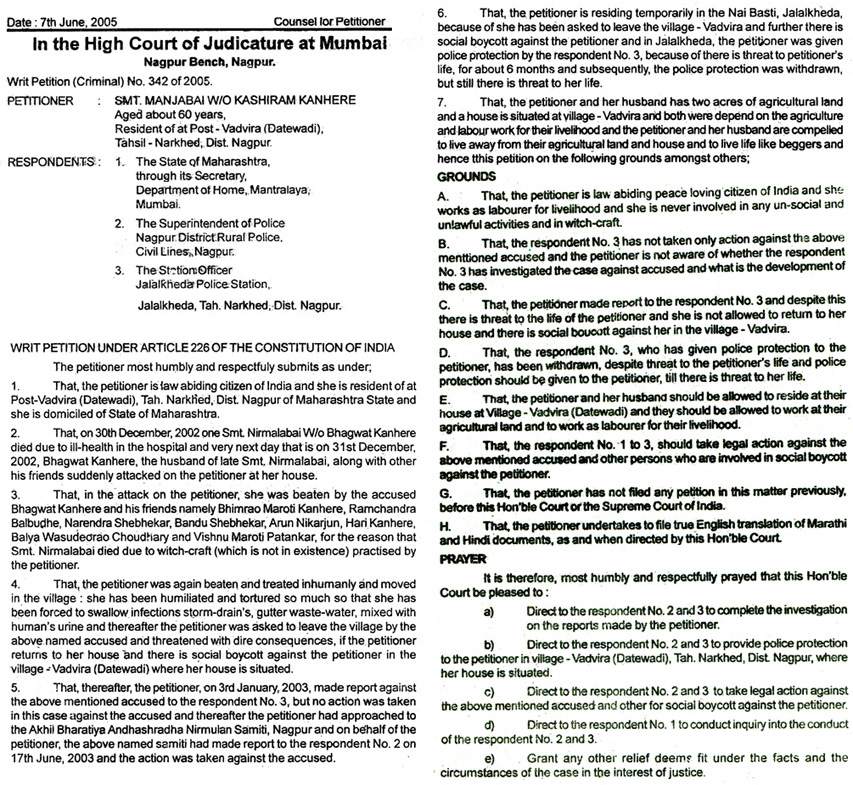(National Geographic documentary)

Witchcraft is still widely believed in and 'practiced' in many backward
parts of India. Jharkand in Ranchi has been dubbed 'the witch-killing
hub of India' by journalists where women suspected of witchcraft are
attacked and not seldom killed. Historians have estimated that, in
Europe until the 17th to 18th century, ca. 40,000 women were killed
as witches, often by burning at the stake. (The latest well-known
witch trials in an industrialised or developed Western country were
those at Salem, Massachusetts in 1692.)
In Jharkand, five hundred cases of witch hunts were reported in the
1990s, and they continueto occur. The State ratified an Anti Witch-hunting
Law, resulting in 400 arrests since 2000. The journalist Sohaila Kapur
- author of "Witchcraft in Western India" followed one headline-grabbing
witchcraft killing for National Geographic TV Channel. A teenager,
Gurudas Mardi took the severed head of his aunt Maina Mardi to the
police station, having cut off her head while she was grazing cattle
in her field. The reason he gave was that his eldest brother had contracted
a fever and died within one day, his father had died within three
years and his elder brother was currently ill in hospital with the
same symptoms. Gurudas believed his brother would be cured due to
his having killed his aunt as a witch. However, all agreed that Maina
had long been as a mother to him. Gurudas was condemned for murder
and is currently serving in Ghatasila prison in Jharkand.
There were 7 such cases in Jharkand in as many years. Most accused
'witches' are widows. Mostly, others benefit from their deaths or
banishment from their home and property. Part of the witchcraft rationale
is that, if prayers can healat a distance, so can they also harm
from afar. The belief in black magic is backed up by practitioners
of it, such as - in this case - the Tantric 'guru' Baba Ramashankar
of the popular Kali temple at Kamakilija. National Geographic filmed
the 'guru' and three female disciples carrying our sacrifice rituals
so as to obtain magical powers, including biting the head off a live
chicken. The death spells they cast involved use of snakes and scorpions
too. The 'guru' stated that the spells can cause love, hate and confusion.
Sohaila Kapur did a follow-up investigation on the deaths in the familywhich Gurudas Mardi believed due to his aunt's witchcraft. His remaining brother survived due to hospital treatment for TB. The doctor testified that both the father had died from tuberculosis and had infected Gurudas' two brothers.
Further, Sohaila Kapur filmed the local female witch doctor who
Gurudas' family had approached and who had pointed the finger at Maina
for witchcraft holding a trial in the village temple. While so doing
Kapur was approached by a distraught man whose mother was about to
be pointed out condemned as a witch by a same witch doctor in the
village temple. A big local landowner's daughter was ill and many
medicines had failed, so witchcraft was suspected. Because of the
TV cameras, the priest dared not to make the announcement that the
person was a witch and the villagers backed her up. Instead the witch
doctor directed for a tree to be blighted and predicted it would die
within two weeks. Of course, no effects on the tree were visible weeks
later.
The female victims of witch hunts invariably have to seek police protection
and mostly are ostracised and so driven by the villagers to leave
their homes and even give up their properties, their houses etc. often
being burned to the ground. The harrowing lives they then live is
seen clearly in the interviews in the documentary. Inspector Mishra
of Jharkand police, who had arrested Gurudas, blamed the widespread
ignorance and lack of medical information and care in the area for
the locals reliance on witch-hunting. See also here.
Police authorities do
not automatically take action to protect persons wrongly persecuted for witchcraft.
This is shown by the petition (by a person wrongly accused of witchcraft) in the
High Court at Mumbai.

That the above petition was undertaken
(a costly, lengthy and uncertain procedure in India) and its subsequent
dismissal in favour of account by the police authorities' clearly
shows the most parlous state of affairs in much of the Indian police system and judiciary!
This same judicial system judged that Sathya Sai Baba had
not contravened the Gold Control Act on the grounds that he actually materialises
gold out of thin air! Further, the petition by Hari Sampath - forwarded
by two of India's most foremost lawyers - against
Sathya Sai Baba was refused a hearing on a legal technicality by his devotee
judges in the Supreme Court (Click
here and here)!